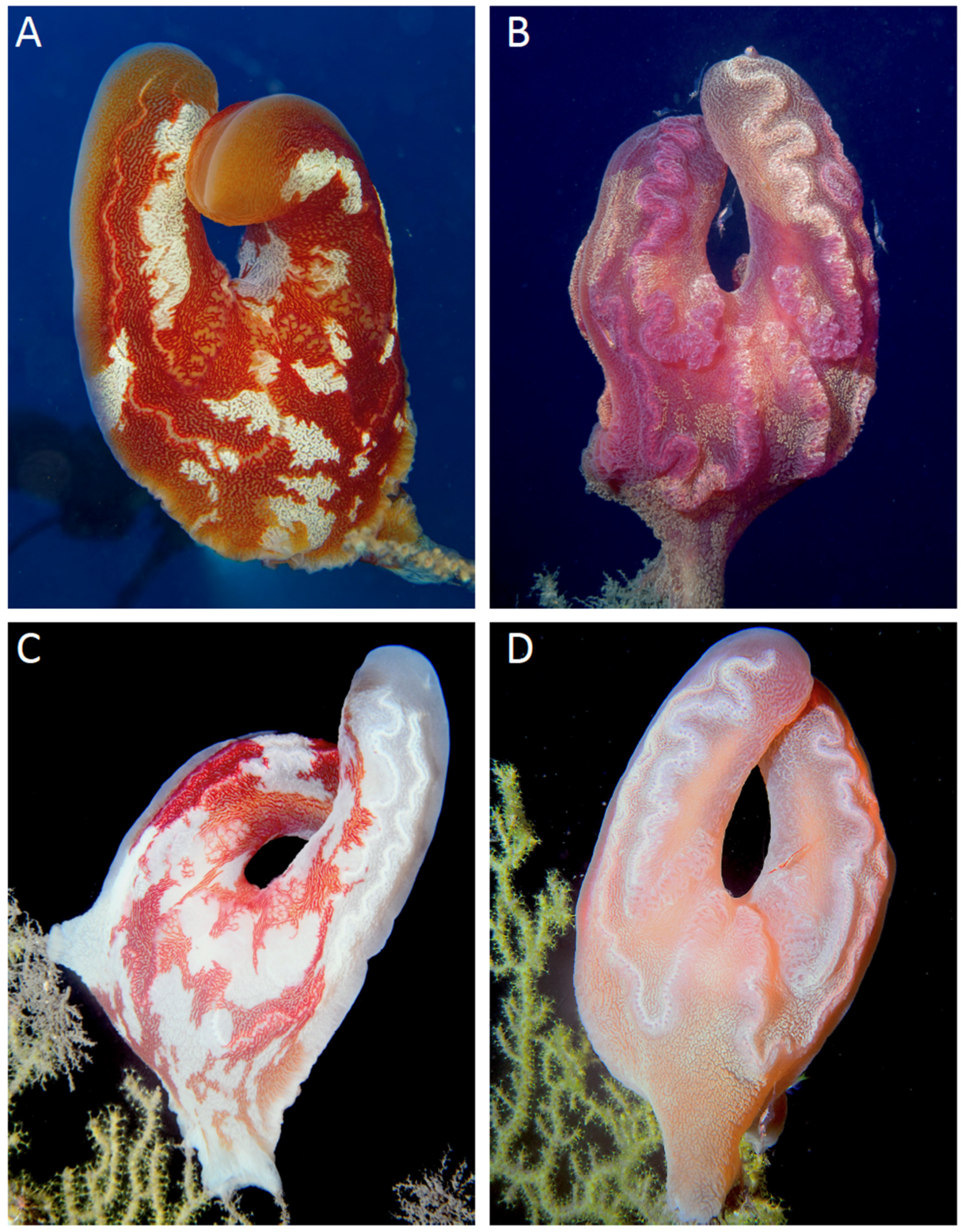A Rare Benthic Ctenophore, Lyrocteis cf. imperatoris, at Mesophotic Depths off Réunion Island
Abstract
Author Contributions
Funding
Institutional Review Board Statement
Data Availability Statement
Conflicts of Interest
References
- Komai, T. A New Remarkable Sessile Ctenophore. Proc. Imp. Acad. 1941, 17, 216–220. [Google Scholar] [CrossRef]
- Robilliard, G.A.; Dayton, P.K. A new species of platyctenean ctenophore, Lyrocteis flavopallidus sp. nov., from McMurdo Sound, Antarctica. Can. J. Zool. 1972, 50, 47–52. [Google Scholar] [CrossRef]
- Song, J.-I.; Hwang, S.-J. First record of one sessile ctenophora, Lyrocteis imperatoris, and its embryos from Korea. Korean J. Syst. Zool. 2009, 25, 255–259. [Google Scholar] [CrossRef]
- Shepherd, B.; Pinheiro, H.T.; Rocha, L.A. Ephemeral aggregation of the benthic ctenophore Lyrocteis imperatoris on a mesophotic coral ecosystem in the Philippines. Bull. Mar. Sci. 2018, 94, 101–102. [Google Scholar] [CrossRef]
- Fassbender, N.; Stefanoudis, P.V.; Filander, Z.N.; Gendron, G.; Mah, C.L.; Mattio, L.; Mortimer, J.A.; Moura, C.J.; Samaai, T.; Samimi-Namin, K.; et al. Reef benthos of Seychelles—A field guide. Biodivers. Data J. 2021, 9, e65970. [Google Scholar] [CrossRef] [PubMed]
- Gibbons, M.J.; Haddock, S.H.D.; Matsumoto, G.I.; Foster, C. Records of ctenophores from South Africa. PeerJ 2021, 9, 10697. [Google Scholar] [CrossRef] [PubMed]
- Boissin, E.; Bourmaud, C.A.-F.; Ballesta, L.; Mulochau, T.; Gravier-Bonnet, N. Millepora aff. exaesa (Cnidaria, Hydrozoa) Recorded in the Mesophotic Environment of Mount La Pérouse, Southwestern Indian Ocean—Expedition La Pérouse 2019. Diversity 2021, 13, 474. [Google Scholar] [CrossRef]
- Gravier-Bonnet, N.; Boissin, E.; Hoarau, L.; Plantard, P.; Loisil, C.; Ory, D.; Mulochau, T.; Chabanet, P.; Adjeroud, M.; Bourmaud, C.; et al. Diving into the lower mesophotic coral ecosystems (65–93 m depth) of Reunion Island (Southwestern Indian Ocean) sheds light on the hidden diversity of hydroids (Cnidaria, Hydrozoa). Mar. Biodivers. 2022, 52, 38. [Google Scholar] [CrossRef]

Disclaimer/Publisher’s Note: The statements, opinions and data contained in all publications are solely those of the individual author(s) and contributor(s) and not of MDPI and/or the editor(s). MDPI and/or the editor(s) disclaim responsibility for any injury to people or property resulting from any ideas, methods, instructions or products referred to in the content. |
© 2025 by the authors. Licensee MDPI, Basel, Switzerland. This article is an open access article distributed under the terms and conditions of the Creative Commons Attribution (CC BY) license (https://creativecommons.org/licenses/by/4.0/).
Share and Cite
Boissin, E.; Plantard, P.; Siu, G.; Loisil, C.; Sparton, N.; Gravier-Bonnet, N. A Rare Benthic Ctenophore, Lyrocteis cf. imperatoris, at Mesophotic Depths off Réunion Island. Diversity 2025, 17, 447. https://doi.org/10.3390/d17070447
Boissin E, Plantard P, Siu G, Loisil C, Sparton N, Gravier-Bonnet N. A Rare Benthic Ctenophore, Lyrocteis cf. imperatoris, at Mesophotic Depths off Réunion Island. Diversity. 2025; 17(7):447. https://doi.org/10.3390/d17070447
Chicago/Turabian StyleBoissin, Emilie, Patrick Plantard, Gilles Siu, Camille Loisil, Nicolas Sparton, and Nicole Gravier-Bonnet. 2025. "A Rare Benthic Ctenophore, Lyrocteis cf. imperatoris, at Mesophotic Depths off Réunion Island" Diversity 17, no. 7: 447. https://doi.org/10.3390/d17070447
APA StyleBoissin, E., Plantard, P., Siu, G., Loisil, C., Sparton, N., & Gravier-Bonnet, N. (2025). A Rare Benthic Ctenophore, Lyrocteis cf. imperatoris, at Mesophotic Depths off Réunion Island. Diversity, 17(7), 447. https://doi.org/10.3390/d17070447







